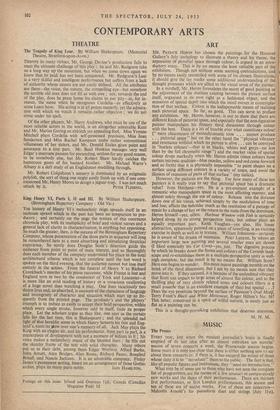ART
MR. PATRICK HERON has chosen the paintings for the Hanover Gallery's July anthology to illustrate a theory and his theme, the expression of pictorial space through colour, is argued in an intro- ductory essay. This is by no means the least valuable part of the exhibition. Though not without some seeming contradictions, and. by no means easily reconciled with some of his chosen illustratjons, it should give the lay reader some additional understanding of the thought processes which are allied to the visual sense of the painter. In a nutshell, Mr. Heron formulates the secret of good painting as the adjustment of the dualism existing between the picture surface itself, organised in its own right as a fashioned object, and the sensation of spatial depth into which the mind moves in contempla- tion of that surface. Colour is the indispensable means of realising such pictorial space. So far, so good. This can serve to preface any exhibition. Mr. Heron, however, is out to show that there are different kinds of pictorial space, and especially that the non-figurative painter manipulates his illusory third dimension through colour with the best. There is a bit of trouble over what constitutes colour (" mere chiaroscuro of monochromatic tone. . . cannot produce . . . pictorial space" but on the other hand the "physical vibrancy and resonance without which no picture is alive . . . can be conveyed in 'hueless colours'—that is in blacks, whites and greys—no less than by the full chromatic range") and the market value of spatial colour drops markedly when Mr. Heron admits (since colours have certain intrinsic qualities—blue recedes, yellow and red come forward and so forth) that it is physically impossible "to paint shapes on a surface using different colours in a variety of tones, and avoid the illusion of recession of parts of that surface" (my italics). However, the pictures are the thing. For how many of these ten painters is it really true to say that pictorial space has a dramatic value? Ivon Hitchens—yes. He is a pre-eminent example of a romantic who manipulates space in the most affecting manner, and almost solely through the use of colour. Release into the distance down one of his vistas, achieved simply by the modulation of tone and hue, affects the beholder much as the resolution of a passage of music by a change of key or the return to the tonic from the dominant. Heron himself—yes, often. Harbour Window with Fish is certainly helped along by its strong perspective lines, but colour plays an equally important part. Keith Vaughan—yes also. His linear abstraction, apparently painted on a piece of towelling, is an exciting exercise in depth as well as in texture. William Johnstone—certainly he is aware of the drama of recession. Peter Lanyon, by whom an important large new painting anti several smaller ones are shown (I liked especially his Cut Corn)—yes, just. The digestive process by which he breaks down the forms and colours of the Cornish land- scape and re-establishes them in a multiple-perspective unity is well- nigh complete, but the result is by no means flat. William Scott? Here one begins to wonder. His more recent paintings tremble on the brink of the third dimension, but I am by no means sure that they move into it. If they succeed, it is because of the undoubted vibrancy that Scott can impart to large areas of almost flat colour, and to the thrilling play of very closely related tones and colours (there is a small gouache that is an excellent example of this) but spatial . . .? Does the eye penetrate beyond the surface of Pasmore's Oval Motif, Terry Frost's Black and White Movement, Roger Hilton's No. 16? This latter, conceived in a spirit of wilful naïveté, is surely just as flat as a painting can be.
This is a thought-provoking exhibition that deserves attention.
M. H. M.


























 Previous page
Previous page